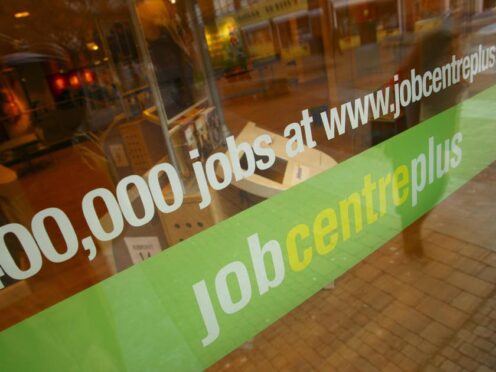Britain’s unemployment rate has risen to its highest level for nearly a year as further cracks show in the jobs market, according to official figures.
The Office for National Statistics (ONS) said the rate of UK unemployment rose to 4.3% in the three months to March, which is the highest since May to July last year and up from 4.2% in the previous three months.
The figures also showed regular average earnings growth remaining unchanged at 6% in the three months to March.
While this helped wages outstrip Consumer Prices Index (CPI) inflation by 2.4% – the highest since the three months to August 2021 – it is unhelpful for the Bank of England in its battle to rein in inflation.

The Bank is watching the jobs market and wages in particular closely as it looks to bring CPI back to its 2% target, and cooling earnings growth is seen as being key to paving the way for it to begin cutting interest rates.
Most economists were expecting earnings growth to fall to 5.9%, marking the second time in a row that the decline in earnings growth has failed to match forecasts.
Experts said the Bank will be looking at the next set of job numbers carefully, given last month’s near 10% rise in the National Living Wage, while it will also likely want to see further progress toward target in the upcoming April inflation data.
Liz McKeown, ONS director of economic statistics, said: “We continue to see tentative signs that the jobs market is cooling.
“At the same time the steady decline in the number of job vacancies has continued for a 22nd consecutive month, although numbers remain above pre-pandemic levels.”
In other signs of a cooling jobs market, more timely figures from HM Revenue & Customs estimated the number of UK workers on payrolls tumbled by 85,000 to 30.2 million in April, which is the largest fall since May 2020, although the ONS said this was subject to revision.

Vacancies in the jobs sector also dropped by 26,000 quarter on quarter to 898,000 in the three months to April.
Chancellor Jeremy Hunt said: “This is the 10th month in a row that wages have risen faster than inflation, which will help with the cost-of-living pressures on families.
“While we are dealing with some challenges in our labour supply, including pandemic impacts, as our reforms on childcare, pensions tax reform and welfare come online I am confident we will start to increase the number of people in work.”
The data comes after official figures last week showed the UK emerged from a short and shallow recession, with gross domestic product (GDP) up 0.6% in the first three months of the year.
Experts said the latest jobs data showed the impact of interest rates remaining at their highest since 2008, at 5.25%.
Alice Haine, personal finance analyst at Bestinvest, said: “The likelihood of a summer rate cut, with many consumers pinning their hopes on a move as early next month, may be slightly dented by the better-than-expected pay growth data.”

Rob Wood, of Pantheon Macroeconomics, said he believed a rate cut in June was still “on track” despite the strong wages growth.
“That said, strong wage growth will likely stop the Monetary Policy Committee cutting bank rates quickly,” he said.
Peter Arnold, EY UK chief economist, said Bank rate setters would be encouraged by the ONS data showing private sector jobs growth edging down to 5.9% in the three months to March.
But economists remain cautious over the ONS data, as the statistics body continues to overhaul its labour force survey due to low response rates, with the full revamped version not due to be introduced until September.
The ONS estimated there were 22,000 working days lost to strike actin across the UK in March.
It added that the number of people classed as economically inactive rose to 9.4 million in the first three months of 2024 – up 1.1% quarter-on-quarter and 3.3% higher than a year earlier.
